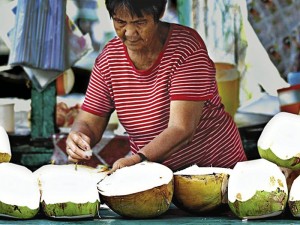
EXPORT MATERIAL. Besides coconut water, the coconut husks could be the next big thing in the export industry. INQUIRER FILE PHOTO
MANILA, Philippines—The coconut industry is expected to get a further boost once it capitalizes on its potential to be a top exporter of cocopeat, a fibrous substance made from coconut husks.
The Philippine Center for Postharvest Development and Mechanization (PhilMech) said that given the proper post-harvest technology, the Philippines could easily make export-grade cocopeat and become its biggest supplier worldwide with the sheer size of lands devoted to coconut trees.
PhilMech is mandated to conduct research on the ways farm waste could be put to good use.
The agency said it had developed a two-step drying system with its partners in order to produce quality cocopeat.
Cocopeat is a by-product of coconut husk and is used as a growing medium for plants using hydroponics, a method of growing crops without using soil only water.
Popular in hydrophonics
PhilMech said cocopeat is becoming more popular in hydroponics, noting that it has a water retention capacity of up to eight times its weight. Cocopeat needs less watering compared to peat moss, which is also used in hydroponics. It is resistant to bacteria, weed and fungal growth and can be used for up to eight years.
According to PhilMech, the Philippines has enough coconut trees to overtake India and Sri Lanka, the current top cocopeat suppliers.
Both countries export more cocopeat even if India only has one million hectares of coconut lands and Sri Lanka has only about 1.76 million ha planted to coconuts. In comparison, the Philippines has 3.3 million ha of coconut lands.
“If only 30 percent of discarded coconut husks were processed into high-grade cocopeat, the Philippines could be the largest supplier of the commodity internationally,” said PhilMech executive director Rex Bingabing in a statement, quoting a recent study initiated by the agency.
The PhilMech study, conducted by a team led by Manolito Bulaong, discovered that the Philippines exported only 5,000 metric tons of cocopeat, while India and Sri Lanka exported 400,000 MT and 82,000 MT, respectively, in 2011.
If 30 percent of coconut husks in the Philippines are turned into cocopeat, the country could produce 562,000 MT.
Export-grade cocopeat
Bingabing said the discarded coconut husks in the country need to be harvested and processed through the proper drying technologies so that they could be turned into export-grade cocopeat.
According to PhilMech, it would be best if mechanical dryers were used for the production because of the country’s rainy season. In India and Sri Lanka, sun drying is used for its production.
PhilMech also recommended that cocopeat undergo mechanical dewatering before drying to ensure the quality of the output.
The agency said it had teamed up with accredited manufacturer Suki Trading and exporter Filcoco to develop the drying system to produce export-quality cocopeat.
It said a belt press should be used to dewater the cocopeat and reduce its moisture content by as much as 60 to 65 percent, while a rotary drum dryer heated by a biomass furnace would dry it further and bring moisture levels down to 16 percent. At that point, the cocopeat could be formed into blocks for export.
It also recommended that more studies be done to improve the type of drum dryer used.